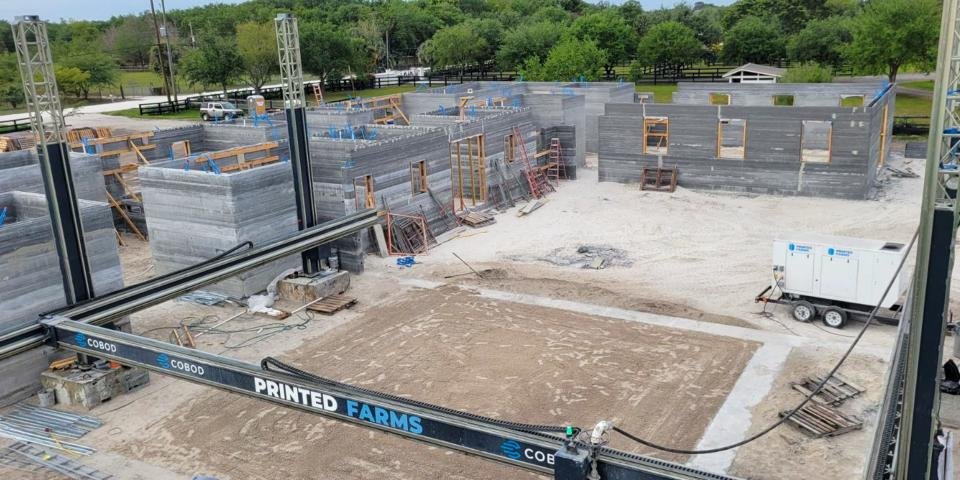Press Release - Harcourt Technologies LTD and Cundall Ireland pioneer project to standardise construction regulations for the 3D construction printing sector
A new method of 3D construction printing directly on site, developed in Ireland, has the potential to revolutionise the construction world by providing a faster, cheaper, and more sustainable way to build. The method focuses initially on standardised housing schemes and social housing developments, aiming to streamline the building process and reduce costs.
This fully regulatory-compliant approach is now being rolled out on the first 3D construction printed housing scheme in Ireland.
Created by 3D construction printing specialists, Irish companies Harcourt Technologies Ltd (HTL), and Harcourt Architects in collaboration with global multi-disciplinary engineering consultancy Cundall, this joint project is the first of its kind in Ireland and the UK. Initial work is underway to begin the roll out of this housing project in Ireland later this year, and the scheme will revolutionise the construction industry by providing comprehensive guidelines and regulations for 3D construction printing processes, ensuring efficiency, quality, and safety for future projects.
This joint initiative is geared towards the development of a proposed residential housing scheme delivered using COBOD International A/S 3D construction printing technology. By collaborating on this venture, Cundall, HTL, and Harcourt Architects are deploying the technology to comply with the existing Irish Building regulatory framework. This is the first step towards establishing 3D construction printing regulations for the widespread adoption of this innovative construction method.
3D construction printing has the potential to change the construction industry globally, offering rapid, cost-effective, and sustainable solutions. Notable projects using the COBOD B0D2 3D construction printer include projects in the US by Florida-based Printed Farms, who have completed the current largest 3D printed building in 2023, a luxury horse barn. The project has a total floor area of 940 m2 (+10,100 sq. ft), designed to withstand the extreme weather challenges of the hurricane-prone region, with a substantial focus on structural integrity and occupant safety.
In Saraburi, Thailand, Siam Cement Group has completed the new 2-story medical centre is 345m2 (3,712 sq. ft)) and the largest 3D-printed building in South East Asia.
A recent project by the Danish 3DCP Group in Lviv, Ukraine, showcased the transformative power of 3D construction printing. Their 500 m2 (5,382 sq. ft) school printing initiative has gained global attention for its ability to facilitate rapid, cost-effective, and sustainable reconstruction in post-conflict scenarios, underscoring the immense potential of this cutting-edge technology.
However, the lack of standardised construction details and regulations has been a hindrance to its widespread implementation in Ireland and the UK. The collaboration between Cundall and HTL aims to bridge this gap by developing a comprehensive set of standard guidelines for 3D construction printing, covering all aspects from design considerations to execution to ensure that the building complies with all relevant building codes and standards.
"We are thrilled to partner with Cundall in this game-changing initiative in the residential construction sector," said Marchant van den Heever, CTO at HTL. "By working together to create standardised construction details for 3D construction printing, we aim to not only enhance the efficiency and quality of future residential construction projects but also pave the way for a regulated and standardised approach to 3D construction printing across the industry."
The proposed residential project in Ireland will leverage the extensive knowledge, research, and technological capabilities of both Cundall and HTL. Through meticulous analysis, testing, and collaboration, the companies are currently developing a comprehensive framework that encompasses key considerations, such as material specifications, structural integrity, building code compliance, and environmental sustainability.
Gerard Doyle, Associate Director at Cundall Ireland, believes this collaboration is just the beginning of the journey.
“The opportunity to develop an engineering solution to bring 3DCP from concept to a viable, sustainable and robust form of construction is truly exciting,” he said. “Most importantly, we are embarking on a method of constructing buildings that can meet the current needs of delivering safe, sustainable buildings quickly, without compromising on design, quality or longevity.”
This collaboration is the beginning of the journey. The next steps are to continue to refine and optimise construction details with a view to using less material, producing less construction waste and ultimately providing a more sustainable way to construct robust buildings. The advantages of 3DCP reach beyond the technology itself. It unlocks the ability to pre-order components based upon consistent, repeatable tolerances that bring efficiencies of assembly line production to the building site.
"This joint project represents a significant step forward in advancing the field of 3D construction printing in the residential construction sector”, said Justin Kinsella, MD & Founder at HTL. “HTL is engaging with industry stakeholders, government bodies, and construction professionals to ensure the roll-out of the proposed residential project. By working together on the development of essential standards and regulations, the industry can embrace the transformative potential of 3D construction printing while ensuring the highest quality and compliance standards.
“Our collaboration with Cundall Ireland will not only streamline the adoption of this revolutionary technology but also ensure the highest standards of safety, quality, and efficiency for future 3D construction printing projects."
The impact of this joint project extends beyond the immediate collaboration between Cundall and HTL. The aim is that the standardised construction details and regulations developed through this initiative will serve as a cornerstone for the entire housing construction sector, enabling future projects to benefit from a uniform and regulated approach to 3D construction printing.
![DRAFT - Cundall and HTL bring the future of construction to Ireland - 200723[81]_page-0001.jpg](https://images.squarespace-cdn.com/content/v1/615e077e74d72b4d244bbd2c/1691408304592-UGAC67G1K2FJHDM11FVS/DRAFT+-+Cundall+and+HTL+bring+the+future+of+construction+to+Ireland+-+200723%5B81%5D_page-0001.jpg)
![DRAFT - Cundall and HTL bring the future of construction to Ireland - 200723[81]_page-0002.jpg](https://images.squarespace-cdn.com/content/v1/615e077e74d72b4d244bbd2c/1691408310931-EV9PJF9KEZB2ROZRHM2A/DRAFT+-+Cundall+and+HTL+bring+the+future+of+construction+to+Ireland+-+200723%5B81%5D_page-0002.jpg)
![DRAFT - Cundall and HTL bring the future of construction to Ireland - 200723[81]_page-0003.jpg](https://images.squarespace-cdn.com/content/v1/615e077e74d72b4d244bbd2c/1691408314446-TVZR59XY6AII58T3BDYV/DRAFT+-+Cundall+and+HTL+bring+the+future+of+construction+to+Ireland+-+200723%5B81%5D_page-0003.jpg)
![DRAFT - Cundall and HTL bring the future of construction to Ireland - 200723[81]_page-0004.jpg](https://images.squarespace-cdn.com/content/v1/615e077e74d72b4d244bbd2c/1691408320645-19Y8UGP6M2F8AW5TVQ71/DRAFT+-+Cundall+and+HTL+bring+the+future+of+construction+to+Ireland+-+200723%5B81%5D_page-0004.jpg)





